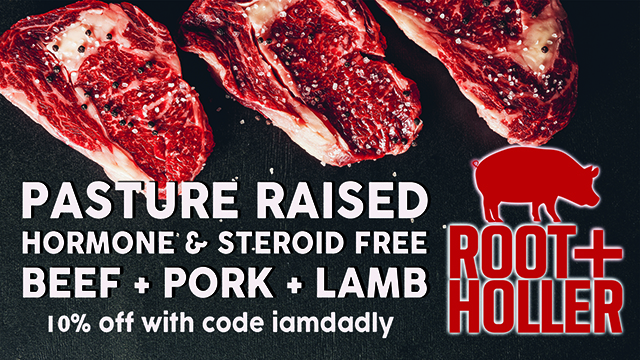9 Tips for Grilling Grass-Fed Beef

Are your grass-fed steaks like beef jerky after you’re done grilling?
Grilling grass-fed beef is not as difficult as you think. Here are our 9 best tips for grilling grass-fed beef.
Though leaner in terms of fat content within muscle fibers, grass-fed beef is wonderfully tender if cooked at more gentle temperatures. Grass-fed beef will have more variation than grain-fed, feedlot beef because of sustainable farming practices, pastures, and individual animal characteristics. But, the key to tender grass-fed beef is to work with that variability and prepare your beef at a lower temperature. Want a few other tips on preparing your grass-fed beef?
1. Choose the best cuts of beef for grilling.
When it comes to the grilling, not all beef cuts are created equal. Ribeye, T-bones, Porterhouse, NY Strips, and sirloins are the best cuts for grilling. All of these cuts come from the most tender parts of the steer. Other steaks great for grilling include tri-tip, filet, flat iron, skirt and flank (though it is recommended to marinate flank and skirt for 6+ hours to tenderize).
Some cuts are better suited to smoking, braising, or slow cooking. We advise to avoid grilling the following cuts: round steaks, stew meat, ribs, and cubed steak.
2. You don’t need to spend a lot of money.
Filets can be quite expensive, especially if you char and overcook it! Instead, perfect grilling steaks include some terrific, less expensive cuts: Chuck Eye, Try-Tip and Sirloins. Other steaks great for grilling but in need of marinating include flank, skirt and eye of round. Of course, you can stretch your budget even further by using beef in recipes in which it is sliced before serving: fajitas, steak salads, and crostinis. Each steak can feed several people if it’s combined with other ingredients.
3. Use a marinade to add flavor and/or tenderize.
Two reasons for marinating beef before grilling: to add flavor and to tenderize the beef. Tender steaks like the T-Bone and NY Strip require less time to marinate because of their fat content. Marinate these steaks for 2 hours or less; any longer, the steaks become mushy. For less tender steaks, marinate in a marinade with acid in it (vinegar, etc.) for 6+ hours. This gently seasons the beef and the acid in the marinade breaks down the fibers within the meat. A handy tip is to use 1/4 cup of marinade per 1 lb of beef.
4. Make your own spice rub.
Did you know that most commercial spice rubs consist mostly of salt! Talk about a rip-off…You can easily make your own by combining your favorite spices from your pantry. Or you can use fresh herbs, like rosemary.
Of course, dry rubs are best for grilling. Apply a small amount of olive oil to the steak, then rub in the spices up to 2 hours prior to grilling.

5. Heat your grill to 400° F.
The correct temperature for grilling is 400 degrees. Cook too hot, and your meat will be tough. Cook too cool, and the grill will fizzle before the meat is done.
6. Always follow the 4-4-4 rule.
The 4-4-4 rule is an easy way to tell when the grill is ready: hold 4 fingertips, 4 inches above the grill, for 4 seconds. If you have to remove your fingers before 4 seconds then the grill is too hot, longer than 4 seconds and the grill isn’t hot enough.
7. Only flip once!
Every time you disturb the steak, it loses moisture and flavor. Flip it just one, halfway through cooking so the steak remains moist and juicy. The steak is ready to flip once the edges are deep brown in color with black grill marks, and moisture is pooling in the top middle of the steak.
Overcooking is the biggest culprit for tough grass-fed beef. Remember, grass-fed beef is best for rare to medium rare cooking.
8. Use a meat thermometer every time.
Want to know a foolproof way to tell when meat is cooked perfectly? Use a meat thermometer. There are a few tricks to make sure your thermometer is working correctly:
- Calibrate your thermometer by dipping it into ice water. It should read 32° F. If it’s off by a few degrees, take that into account when measuring meat later on.
- Most dial meat thermometers have a temperature sensor from the pointed tip up to the notch, or dimple, on the side of the thermometer. To get an accurate reading, place the thermometer into the side of the steak, all the way up to the notch.
9. This trick will help you avoid overcooking your beef.
Customize your grilling experience by cooking your beef as rare or well done as you like! Remember, because grass fed beef has high protein and low fat levels, the beef will usually require 30% less cooking time. And it will continue to cook when removed from heat. For this reason, remove the beef from your heat source 10 degrees before it reaches the desired temperature.
USDA temperature guidelines suggest that beef should be cooked to a minimum temperature of 145 degrees. Now, that guideline applies to the grain-fed commodity beef bought in grocery stores. For our grass-fed beef, you want to cook the steak to an internal temperature of 120 degrees of rare, 140 degrees for well-done.
I Am Dadly highly recommends Root + Holler‘s grass-fed Angus beef, Berkshire pork and lamb. Check them out here.




